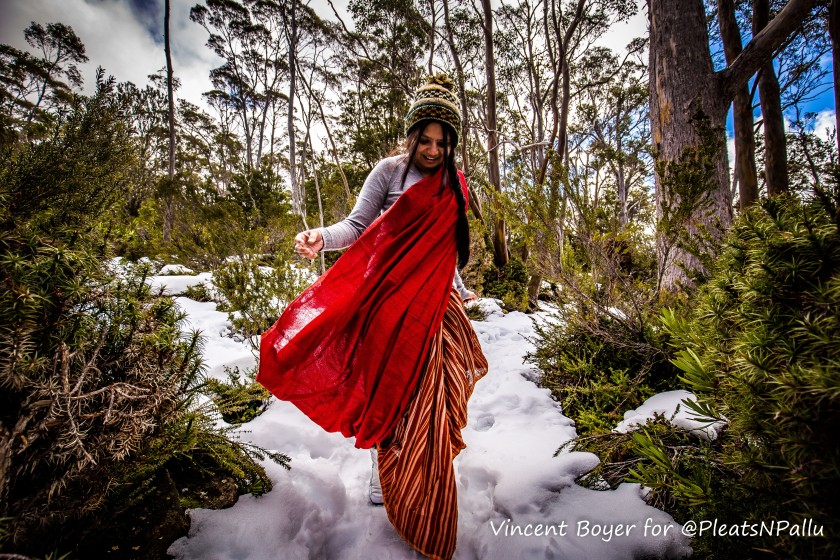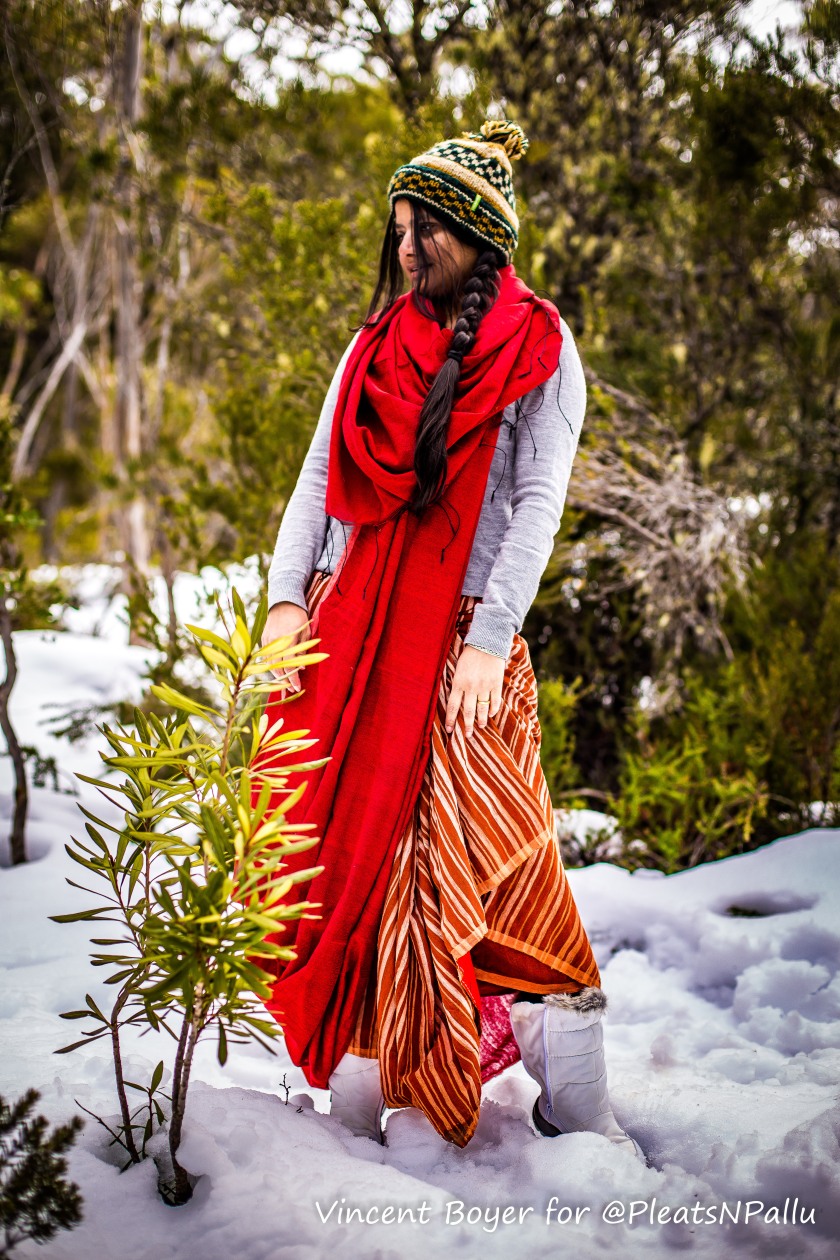Wearing a saree and going for an alpine hike in a snow covered winter wonderland can be heaps fun and one can definitely be comfortable …




Photos: Vincent Boyer (Say hi on instagram @vincetravelbook)
Imagine walking across a dreamy snow covered forest floor, magical flakes falling all around you and peaks covered in fresh powder … Untouched, pristine landscape with just our footsteps and the absolute silence that comes from being far away from civilisation.
I posted a sneak peak of these photos in my instagram stories a couple of weeks ago and got a bunch of queries from people asking me how I managed a photo shoot in a saree in the snow. That got me thinking, first things first this isn’t a photo shoot, the saree was worn in the morning, we travelled in it to reach the alpine forests and walked up the slopes to witness landscapes that seemed right out of a painting.
Secondly, subzero temperatures don’t mean that one has to be uncomfortable, it just means that one has to be prepared. However, it is good to always remember that alpine weather is unpredictable and a fine sunny day can quickly deteriorate into cold, wet, high wind or blizzard conditions.
One’s clothing, therefore, must be versatile and one should have ready access to protective clothing all day. Alpine conditions demand the best gear and I make sure I don’t compromise on the quality of stuff I get. Activities in the snow alternate between moments of high warmth (effort) and rapid cool down and the key to stay comfortable is to stay dry.
I have written a post before on how I stay warm and toasty wearing sarees in the colder months, you can read it here. I will just add what I have done to be comfortable on the day that these photos were taken:
- Waterproof snow boots: Sneakers and running shoes don’t provide enough support or sufficient traction to walk in the snow. When I go hiking or backpacking in an alpine environment that’s rugged, steep and exposed, and may involve some challenging, off-trail hiking along difficult rated trails I bring out my heavy-duty padded waterproof boots. The extra height and stiffness of the right boots provides an extra dose of traction and helps support the climber in steep terrain packed with snow.
- The right socks: When I am hitting the slopes or just hanging about in the snow, I want my feet to be dry, protected and cushioned. My snow socks worn over my pants are also merino wool, ergonomically designed the longer length socks offer comfort plus natural temperature control.
- Insulating Layers: I am wearing several thin layers that trap air and are made of merino wool that stays warm, even when wet. From thermal underwear to base and mid layers, all of what you can’t see are helping insulate against the cold. Cotton performs poorly in cold and wet conditions even when covered by a thick woollen sweater.
- Skin and Eye Protection: Sunburn can be a serious problem, even on cloudy days. In addition to protective clothing, I always use a good sunscreen with a high SPF to protect skin exposed to direct or reflected sunlight. I didnt need snow goggles for this particular day but they are invaluable in ‘protecting one’s eyes from the glare off the snow (which can lead to ‘snow blindness’).
- Beanie: When not indulging in mountain sports, a helmet isn’t essential, however a beanie is a given with or without a helmet. The one I am wearing here is lambswool and lined with fleece — to protect my ears from the winter chill — and keep my head snug.
- Multiple gloves: I was carrying two pairs of gloves, an inner layer in merino wool and an outer padded, waterproof pair — these are incredibly important if I heading to the snow. I am a complete baby and don’t handle extreme weather well, which is why I go prepared. Not everything needs to be worn all day and by the time these photos were taken I was more comfortable in the layers that I had on me and had taken some stuff including the gloves off.
- Down jackets: These are my favourite workhorse all winter, I was carrying a vest plus a thicker hooded quilted jacket stuffed with duck and goose down. The high quality of insulation gives these kinds of jackets an excellent warmth-to-weight ratio, making it great at keeping me warm when I am enjoying a long day of adventure. I didn’t need to have the jackets on all day but kept them handy in my pack.
- Goretex: My outer layer is my waterproof goretex shell that is completely impervious to rain, sleet and snow, with tiny pores that allows perspiration (water vapour) to pass through it from within. When I bought it the price made my eye water but it is worth every penny. I obviously wasn’t wearing the jacket in these photos because I was in no danger of getting wet.
Also the saree I am wearing here is a noil silk saree, it is a coarse fabric that I love and has become a winter staple, previous post here.
Lastly I’d like to add that it may be more challenging to walk in the snows compared to the summer months, but cold-weather hiking is rewarding. Winter days are blissful, and even stormy weather can produce an atmospheric, memorable journey.